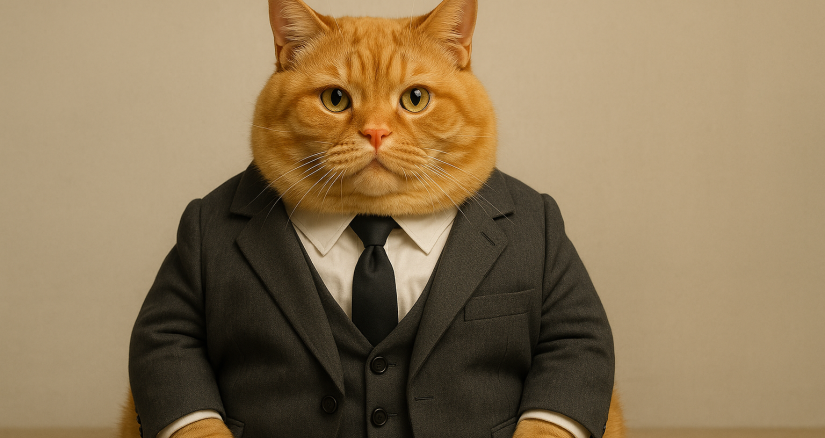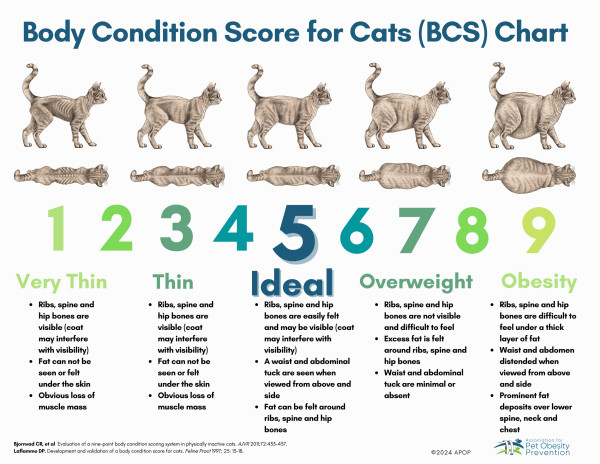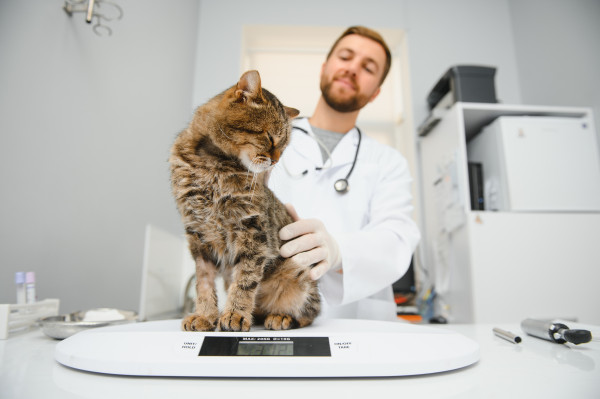
Fat and (Not So) Happy Kitty
September was National Cat Month. Over the past several weeks, social media feeds have been flooded with a surge of adorable feline pictures. Yet, an increasingly common and concerning trend has emerged: the celebration of "fat cats."
Brands and companies often post images of these plump pets for easy engagement due to relatability and “cuteness,” labeling them as "happy" or "chonky." But it’s time to ask a hard question: can a cat be both fat and truly happy?

Source: APOP Body Condition Score for Cats
Is “A Fine Boi” Really Fine? The Crisis of Feline Obesity
The internet loves a "chonky" cat. The rounder, the better, right? This is not just about sharing love; it’s a massive cultural phenomenon. We see it on Instagram accounts with hundreds of thousands of followers, or Facebook groups with almost a million members and group rules that explicitly state: “absolutely no medical advice.” This normalization is fueled by memes like the Feline Chonk Chart or the Body Chunk System (BCS, a play on words for the clinical Body Condition Scoring system), with a 9 out of 9 carrying an affectionate, yet alarming, label, “Oh Lawd He Comin”.
Behind the viral photos and affectionate nicknames is a stark reality: feline obesity is a serious health crisis.
Studies have shown that pet owners who believe "chubby cats are cute" are more likely to have overweight or obese pets. Almost half of the owners surveyed agreed that “chubby (or fat) cats are cute.” Additionally, owners who agreed that “being chubby (or fat) doesn’t affect the cat’s quality of life” were more likely to have an overweight or obese cat. The correlation is clear. We have to ask ourselves: are we loving our pets to death with a kindness that kills?
This isn't about shaming pet owners; it's about changing a dangerous narrative. For years, we've normalized and even celebrated our cats being overweight, mistaking plumpness for contentment. We see a cat with a belly and think they're well-fed and happy. The cartoon, Garfield, may love lasagna, but his perpetual grumpiness might just be closer to the truth. For real-life cats, excessive weight is far from a joke; it’s an epidemic and a serious health crisis we are collectively overlooking, if not actively promoting.
The Silent Pain of an Overweight Cat
The truth is that an overweight cat is often a cat in silent pain. Their extra weight puts a tremendous amount of pressure on their joints, leading to painful arthritis. It puts them at a higher risk of life-threatening conditions like diabetes, heart disease, and urinary problems, just to name a few. They struggle to groom themselves, which can cause skin issues and a painfully matted coat. It can even lead to a shortened life expectancy by five to 10 years.

Photo by sedrik2007
“Oh, Lawd He Comin...” How Do We Stop It?
A fundamental shift in perspective is needed from the animal welfare community, the pet food industry, and the marketers. Three key actions can be done today to help shape a better future for our cats:
- Stop promoting unhealthy images: Instead of defaulting to the “relatable” image of the fat cat to boost engagement, brands and influencers should use their platform to promote healthy and responsible pet care. Let’s celebrate the grace, agility, and longevity of an ideal-weight kitty cat.
- Rethink feeding guidelines: The pet food industry must take closer consideration when formulating and recommending feeding guidelines. For pet owners, navigating the regulatory landscape is difficult enough without overly generic or high-calorie recommendations on the back of the bag. Given the widespread nature of pet obesity, there is a real need for more stringent, standardized regulation to prevent chronic overfeeding based on current product labels.
- Aim to educate and not criticize: To pet owners, the goal isn't shame; it’s support. Weight loss is a challenging journey, not just for the pet but also for its owner. Have compassion for yourself, your pet, and the process. For the vet community, we need a compassionate and non-judgmental approach to help owners recognize that "chubbiness" is a health issue, provide them with practical tools for weight management, and celebrate every small step toward a healthier weight. (Stay tuned for an article specifically focusing on this in the near future.)
The most compassionate thing we can do for our beloved felines is ensure they live the longest, happiest, and healthiest life possible. True love for a cat isn't measured in pounds; it's measured in years of well-being.
What steps can your company or community take today to shift the narrative from celebrating the “chonk” to championing cat health?
Follow us on LinkedIn for the latest updates on all things happening here at BSM Partners.
About the Author
Dr. Stephanie Clark is a board-certified companion animal nutritionist, veterinary nurse and nutrition specialist, a pet owner, and a mother who had a baby during the formula shortage. She has spent the past almost two decades dedicating her career to the welfare of pets, livestock, and wildlife. She currently provides nutritional consultations for veterinary clinics and works in the pet food industry.
This content is the property of BSM Partners. Reproduction or retransmission or repurposing of any portion of this content is expressly prohibited without the approval of BSM Partners and is governed by the terms and conditions explained here.